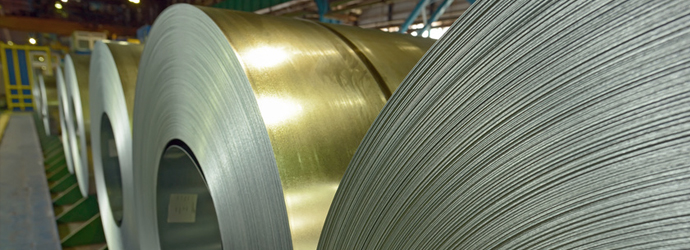Hot- and Cold-rolled Steel
A distinction is made between hot- and cold steel rolling. Hot rolling happens if the temperature of the metal is above its recrystallization temperature. As a guideline the hot working temperature of a material is about 65% of its melting temperature. Cold rolled steel is essentially hot rolled steel that has had further (cold) processing. When steel is hot rolled at temperatures ~930° celsius its shape transforms easily and final products of much larger sizes can be produced. During the cooling process hot rolled performed steel shrinks slightly thus giving less control on the final size and the surface is less smooth. Hot rolled products like steel bars for example are used for the welding and construction manufacturers to create H or I beams. The work process for hot working needs less force and it increases the ductility of the workpiece.

Image above: hot rolled coil;
source fotolia.
Hot rolled coils are produced as a feedstock for cold rolled coils and coated coils but also for immediate use in different industrial applications like steel tubes manufacturing, gas containers, pressure vessels or energy pipelines.
Typically cold rolled steel is processed when the material is cooled at room tmperatur followed by annealing. Cold rolled products provide a superior surface finish, perfect shape conditions and are superior in tolerances compared to hot rolled products. Typically cold rolled products are more expensive than hot rolled due to the fact that hot rolled products often produced without any delays at the steel mill and no reheating is required. Via strain hardening cold rolling increases the strength up to 20% (source: wikipedia). Cold rolling is in need of cluster mills to reduce the thickness of the workpiece as it cannot reduce thickness as much as hot rolling is able in a single pass. About the various conditions cold rolled products are manufactured on wikipedia it is to read: "Cold-rolled sheets and strips come in various conditions: full-hard, half-hard, quarter-hard, and skin-rolled. Full-hard rolling reduces the thickness by 50%, while the others involve less of a reduction. Skin-rolling, also known as a skin-pass, involves the least amount of reduction: 0.5-1%. It is used to produce a smooth surface, a uniform thickness, and reduce the yield point phenomenon (by preventing Lüders bands from forming in later processing). It locks dislocations at the surface and thereby reduces the possibility of formation of Lüders bands. To avoid the formation of Lüders bands it is necessary to create substantial density of unpinned dislocations in ferrite matrix. It is also used to break up the spangles in galvanized steel. Skin-rolled stock is usually used in subsequent cold-working processes where good ductility is required."

Image above: Schematic illustration of a tandem cold rolling mill; Copyright © 2026 build-your-vision.eu
Cold rolled steel is produced through further thickness reduction performed on a strip mill without the use of heat. Hundreds of applications are covered by cold rolled steel products: Automotive components, construction and building components, domestic appliances, electrical goods, furniture ...

cold rolled coils; sorce: fotolia
Steel Strip, Plates, Flats
The following naming conventions are based on commercial classifications. They are used for the image database aswell to have an accurate relationship to the dimension.

Image above: Narrow and Wide Strip; Copyright © 2026 build-your-vision.eu
Hot rolled wide flats: flat product with an width greater than 150 mm and a thickness generally over 4 mm, always supplied in length. Some standard thicknesses are 10, 12, 15, 20, 25 and 30 mm. The edges are sharp.
Hot rolled plate and sheet: edges may be deform freely, delivered in square or rectangular shape, with a width greater than 600 mm, but also in any other shape. The edges may be as-rolled, sheered, flamed out or chamfered. Sheets have a thickness less than 5 mm; plates have a thickness of 5 mm or more.
Hot rolled strip: flat product which is wound to form a coil. The edges are slightly convex. It may also be supplied with sheared edges or slit from wider strip. Hot rolled wide strip: width of 600 mm or over; hot rolled narrow strip: width less than 600 mm.
Cold rolled flat products: flat product which during finishing have undergone a reduction in cross-section of at least 25% by cold rolling without prior reheating.
Cold rolled plate and strip: edges may be deform freely, delivered in square or rectangular shape, with a width greater than 600 mm, but also in any other shape. The edges may be as-rolled, sheered, flamed out or chamfered. Sheets have a thickness less than 5 mm; plates have a thickness equal to or greater than 5 mm or more.
Cold rolled strip: flat product which is wound to form a coil. The edges are slightly convex. It may also be supplied with sheared edges or slit from wider strip. Cold rolled wide strip has a width of 600 mm or over; cold rolled narrow strip has a width less than 600 mm.
